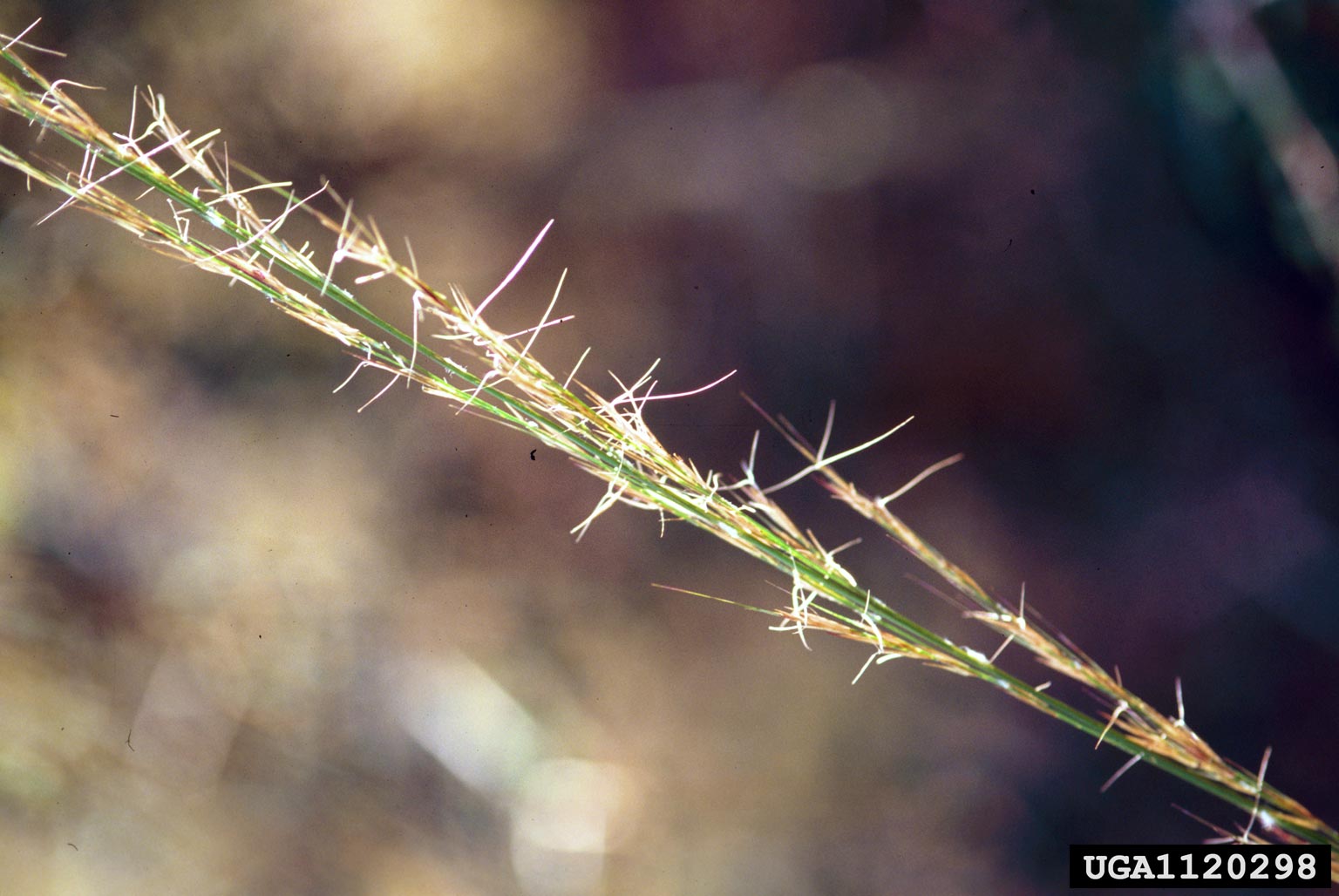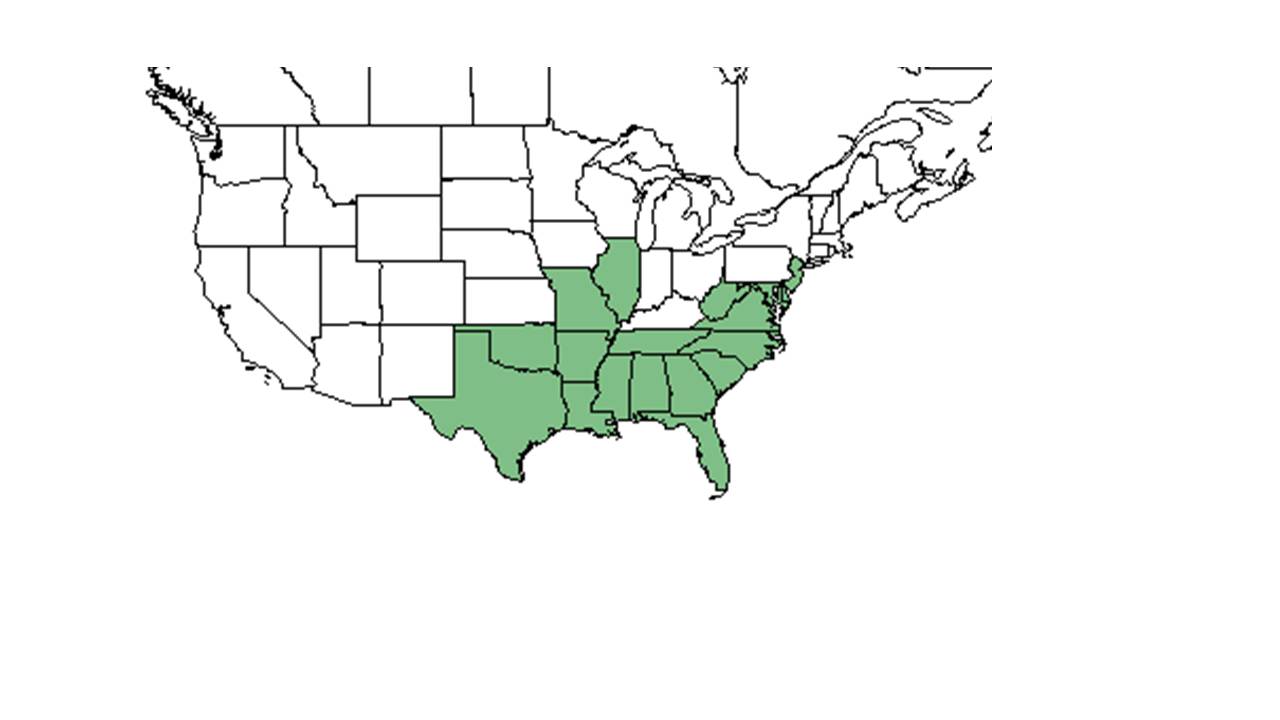Difference between revisions of "Aristida lanosa"
| Line 18: | Line 18: | ||
}} | }} | ||
Common names: Woollysheath threeawn | Common names: Woollysheath threeawn | ||
| − | |||
==Taxonomic notes== | ==Taxonomic notes== | ||
| Line 26: | Line 25: | ||
Tufted perennials. Culms are frequently geniculate, growing 7-12 dm tall. Nodes are glabrous or floccose; branches form lower nodes. Internodes are glabrous. Leaves are mostly low cauline; blades scaberulous beneath on margins and grow up to 4 dm long and 0.5 mm wide. Sheath margins usually scarious and longer than internodes, floccose are lanose. Ligules are short ciliate and 0.1-0.2 mm long. Panicles or racemes are narrow. Panicles are brownish, 3-4.5 dm long. Branches ascending and are scaberulous. Pedicels are unequal and scaberulous. Spikelets are 1-flowered and up to 10-18 mm long, and are frequently in 3’s. The spikelets are disarticulating above glumes. The pedicels are 1-6 mm long. Glumes are 1-nerved or first faintly 3-5 nerve and are scaberulous, margins are usually scarious, acuminate to short-awned, the first glume 10-18 mm long, the second is 9-12 mm long. Lemmas are faintly 3-nerved, spotted-papillose, margins scarious, and frequently enrolled in awns of 3. The lemma body is 8-9 mm long and the awns are ascending to divergent, they are twisted or straight basally, unequal, 5-30 mm long. Paleas are absent. The callus bearded and grow up to 1 mm long. The grain is linear, are yellowish in color, and grow up to 6.5 mm long. Plants are abundant in dry, sterile soils. Flowers from August to October. (Radford 1964). | Tufted perennials. Culms are frequently geniculate, growing 7-12 dm tall. Nodes are glabrous or floccose; branches form lower nodes. Internodes are glabrous. Leaves are mostly low cauline; blades scaberulous beneath on margins and grow up to 4 dm long and 0.5 mm wide. Sheath margins usually scarious and longer than internodes, floccose are lanose. Ligules are short ciliate and 0.1-0.2 mm long. Panicles or racemes are narrow. Panicles are brownish, 3-4.5 dm long. Branches ascending and are scaberulous. Pedicels are unequal and scaberulous. Spikelets are 1-flowered and up to 10-18 mm long, and are frequently in 3’s. The spikelets are disarticulating above glumes. The pedicels are 1-6 mm long. Glumes are 1-nerved or first faintly 3-5 nerve and are scaberulous, margins are usually scarious, acuminate to short-awned, the first glume 10-18 mm long, the second is 9-12 mm long. Lemmas are faintly 3-nerved, spotted-papillose, margins scarious, and frequently enrolled in awns of 3. The lemma body is 8-9 mm long and the awns are ascending to divergent, they are twisted or straight basally, unequal, 5-30 mm long. Paleas are absent. The callus bearded and grow up to 1 mm long. The grain is linear, are yellowish in color, and grow up to 6.5 mm long. Plants are abundant in dry, sterile soils. Flowers from August to October. (Radford 1964). | ||
| − | ==Distribution== | + | ==Distribution==<!-- Basic life history facts such as annual/perrenial, monoecious/dioecious, root morphology, seed type, etc. --> |
The distribution of ''Aristida lanosa'' is from New Jersey, south to Florida, and west to Texas (Weakley 2015). | The distribution of ''Aristida lanosa'' is from New Jersey, south to Florida, and west to Texas (Weakley 2015). | ||
==Ecology== | ==Ecology== | ||
| − | ===Habitat=== | + | ===Habitat===<!--Natural communities, human disturbed habitats, topography, hydrology, soils, light, fire regime requirements for removal of competition, etc.--> |
It occurs in frequently burned upland longleaf pine-wiregrass communities, longleaf and shortleaf pine-oak hickory communities, loblolly pine plantations on Ultisols, the higher parts of pine flatwoods, as well as edges of unburned hardwood foresets (Brockway et al. 1997: FSU Herbarium). Soil conditions range from wet to very well drained and sand to loamy sands. It is found in dry sandy soils of sandhill habitats and fields (Weakley 2015). It can also be found in human disturbed areas such as recreational areas, roadsides, longleaf pine clearings, dry sandy soil of campsites (FSU Herbarium). This species grows in large clumps together (FSU Herbarium). | It occurs in frequently burned upland longleaf pine-wiregrass communities, longleaf and shortleaf pine-oak hickory communities, loblolly pine plantations on Ultisols, the higher parts of pine flatwoods, as well as edges of unburned hardwood foresets (Brockway et al. 1997: FSU Herbarium). Soil conditions range from wet to very well drained and sand to loamy sands. It is found in dry sandy soils of sandhill habitats and fields (Weakley 2015). It can also be found in human disturbed areas such as recreational areas, roadsides, longleaf pine clearings, dry sandy soil of campsites (FSU Herbarium). This species grows in large clumps together (FSU Herbarium). | ||
Associated species include longleaf pine, oak, hickory, ''Pinus echinata, Cornus florida, Eupatorium campositifolium, Callicorpa americana, Quercus hemisphaerica, Homomelis virginiana, Rubus cuneifolius, Vitis rotundifolius,'' loblolly pine, shortleaf pine, and others (FSU Herbarium). | Associated species include longleaf pine, oak, hickory, ''Pinus echinata, Cornus florida, Eupatorium campositifolium, Callicorpa americana, Quercus hemisphaerica, Homomelis virginiana, Rubus cuneifolius, Vitis rotundifolius,'' loblolly pine, shortleaf pine, and others (FSU Herbarium). | ||
| − | ===Phenology=== | + | ===Phenology===<!--Timing off flowering, fruiting, seed dispersal, and environmental triggers. Cite PanFlora website if appropriate: http://www.gilnelson.com/PanFlora/ --> |
It flowers from August to October and has been seen fruiting from October to November (Weakley 2015, FSU Herbarium). | It flowers from August to October and has been seen fruiting from October to November (Weakley 2015, FSU Herbarium). | ||
<!--===Seed dispersal===--> | <!--===Seed dispersal===--> | ||
<!--===Seed bank and germination===--> | <!--===Seed bank and germination===--> | ||
| − | ===Fire ecology=== | + | ===Fire ecology===<!--Fire tolerance, fire dependence, adaptive fire responses--> |
Burning during the growing season is thought to primarily stimulate seed production by important grass species in longleaf pine wiregrass communities, possibly including ''Aristids lanosa'' (Biswell and Lemon, 1943; Streng et. al, 1993 cited by Brockway et al 1997). However, burning during winter is also beneficial. | Burning during the growing season is thought to primarily stimulate seed production by important grass species in longleaf pine wiregrass communities, possibly including ''Aristids lanosa'' (Biswell and Lemon, 1943; Streng et. al, 1993 cited by Brockway et al 1997). However, burning during winter is also beneficial. | ||
<!--===Pollination=== --> | <!--===Pollination=== --> | ||
| − | <!--===Use by animals=== --> | + | <!--===Use by animals===--><!--Herbivory, granivory, insect hosting, etc.--> |
<!--===Diseases and parasites===--> | <!--===Diseases and parasites===--> | ||
==Conservation and Management== | ==Conservation and Management== | ||
| Line 53: | Line 52: | ||
==References and notes== | ==References and notes== | ||
| − | |||
Biswell, H.H. and PC. Lemon, 1943. Effect of fire upon seed-stalk production of range grasses. Journal of Forestry, 41: 844. | Biswell, H.H. and PC. Lemon, 1943. Effect of fire upon seed-stalk production of range grasses. Journal of Forestry, 41: 844. | ||
Revision as of 15:30, 2 March 2016
| Aristida lanosa | |
|---|---|

| |
| Photo by James H. Miller, USDA Forest Service, Bugwood.org | |
| Scientific classification | |
| Kingdom: | Plantae |
| Division: | Magnoliophyta - Flowering plants |
| Class: | Liliopsida – Monocotyledons |
| Order: | Cyperales |
| Family: | Poaceae ⁄ Gramineae |
| Genus: | Aristida |
| Species: | A. lanosa |
| Binomial name | |
| Aristida lanosa Muhl. ex Elliott | |

| |
| Natural range of Aristida lanosa from USDA NRCS Plants Database. | |
Common names: Woollysheath threeawn
Contents
Taxonomic notes
Synonyms: A. lanosa var. lanosa Muhl. ex Elliott; A. lanosa var. macera Fernald & Griscom
Description
Tufted perennials. Culms are frequently geniculate, growing 7-12 dm tall. Nodes are glabrous or floccose; branches form lower nodes. Internodes are glabrous. Leaves are mostly low cauline; blades scaberulous beneath on margins and grow up to 4 dm long and 0.5 mm wide. Sheath margins usually scarious and longer than internodes, floccose are lanose. Ligules are short ciliate and 0.1-0.2 mm long. Panicles or racemes are narrow. Panicles are brownish, 3-4.5 dm long. Branches ascending and are scaberulous. Pedicels are unequal and scaberulous. Spikelets are 1-flowered and up to 10-18 mm long, and are frequently in 3’s. The spikelets are disarticulating above glumes. The pedicels are 1-6 mm long. Glumes are 1-nerved or first faintly 3-5 nerve and are scaberulous, margins are usually scarious, acuminate to short-awned, the first glume 10-18 mm long, the second is 9-12 mm long. Lemmas are faintly 3-nerved, spotted-papillose, margins scarious, and frequently enrolled in awns of 3. The lemma body is 8-9 mm long and the awns are ascending to divergent, they are twisted or straight basally, unequal, 5-30 mm long. Paleas are absent. The callus bearded and grow up to 1 mm long. The grain is linear, are yellowish in color, and grow up to 6.5 mm long. Plants are abundant in dry, sterile soils. Flowers from August to October. (Radford 1964).
Distribution
The distribution of Aristida lanosa is from New Jersey, south to Florida, and west to Texas (Weakley 2015).
Ecology
Habitat
It occurs in frequently burned upland longleaf pine-wiregrass communities, longleaf and shortleaf pine-oak hickory communities, loblolly pine plantations on Ultisols, the higher parts of pine flatwoods, as well as edges of unburned hardwood foresets (Brockway et al. 1997: FSU Herbarium). Soil conditions range from wet to very well drained and sand to loamy sands. It is found in dry sandy soils of sandhill habitats and fields (Weakley 2015). It can also be found in human disturbed areas such as recreational areas, roadsides, longleaf pine clearings, dry sandy soil of campsites (FSU Herbarium). This species grows in large clumps together (FSU Herbarium).
Associated species include longleaf pine, oak, hickory, Pinus echinata, Cornus florida, Eupatorium campositifolium, Callicorpa americana, Quercus hemisphaerica, Homomelis virginiana, Rubus cuneifolius, Vitis rotundifolius, loblolly pine, shortleaf pine, and others (FSU Herbarium).
Phenology
It flowers from August to October and has been seen fruiting from October to November (Weakley 2015, FSU Herbarium).
Fire ecology
Burning during the growing season is thought to primarily stimulate seed production by important grass species in longleaf pine wiregrass communities, possibly including Aristids lanosa (Biswell and Lemon, 1943; Streng et. al, 1993 cited by Brockway et al 1997). However, burning during winter is also beneficial.
Conservation and Management
Cultivation and restoration
Photo Gallery
References and notes
Biswell, H.H. and PC. Lemon, 1943. Effect of fire upon seed-stalk production of range grasses. Journal of Forestry, 41: 844.
Brockway, D. G. and C. E. Lewis (1997). "Long-term effects of dormant-season precribed fire on plant community diversity, structure and productivity in a longleaf pine wiregrass ecosystem." Forest Ecology and Management 96: 167-183.
Florida State University Robert K. Godfrey Herbarium database. URL: http://herbarium.bio.fsu.edu. Last accessed: June 2014. Collectors: Loran C. Anderson, Gary R. Knight, George R. Cooley, H. Allan Gleason, R. Kral, R.K. Godfrey, A. F. Clewell, A. H. Curtiss, A. Gholson Jr., Wilson Baker, James R. Burkhalter, Angela M. Reid, K. M. Robertson, and Bill Boothe. States and Counties: Florida: Wakulla, Okaloosa, Jackson, Hernando, Washington, Liberty, Leon, Holmes, Duval, Gadsden, Santa Rosa, and Calhoun. Georgia: Baker.
Radford, Albert E., Harry E. Ahles, and C. Ritchie Bell. Manual of the Vascular Flora of the Carolinas. 1964, 1968. The University of North Carolina Press. 97-98. Print.
Streng, D.R., Glitzenstein J.S. and Platt, W.J., 1993. Evaluating effects of season of bum in longleaf pine forests: a critical literature review and some results from an ongoing long-term study. In: S.M. Hermann (Editor), Proceedings of the Tall Timbers Fire Ecology Conference. Tall Timbers Research Station, Tallahassee, FL, 18: 227-263.
Weakley, Alan S. Flora of the Southern and Mid-Atlantic States: Working Draft of 21 May 2015. University of North Carolina Herbarium (NCU). PDF. 359.